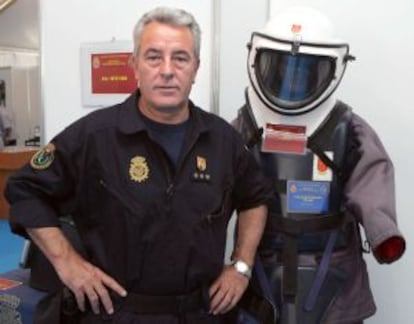“We knew it wasn’t ETA from the start”
Bomb disposal chief publishes book defending unit's handling of 2004 Madrid train bombings


“On March 11 2004 I got up as always at 6.30am [...] It looked like it was going to be day of formalities, calm and institutional [...] At 7.45, as I was approaching the Central Bomb Disposal Unit and NRBQ, situated at the police complex in Canillas, in Madrid, my telephone rang. It was the 091 public assistance line. ‘Is that the chief commissioner of Tedax?’.”
This is how Juan Jesús Sánchez Manzano, head of the bomb disposal unit on the day when an Islamist cell killed 191 people on four Madrid trains, opens his memoir Las bombas del 11-M. Relato en primera persona (The 11-M bombs. A first-person account). The book is a vigorous defense of the actions of the Tedax bomb disposal experts in the investigation, and a direct attack on the main politicians, police officers and journalists responsible for the conspiracy theories who for years tried to put Manzano in the dock as a terrorist collaborator.
Now chief commissioner for the Madrid dormitory town of Móstoles, Manzano details the work of his former unit almost down to the second from the first moment of the attacks at 7.30am. He writes that already at 8.30am that day “Tedax had ruled out” that the trains had been blown up with Titadyne, the brand of dynamite that was previously known to have been used by ETA. Two bombs it had tried to deactivate in El Pozo and in Atocha were an “ivory color” and what they had seen dozens of times in the hands of ETA was “orange and reddish.”
Plain dynamite
In the book, the proceeds from which will go to the National Police’s Orphans Foundation, he stresses that neither he, nor anyone in his unit, told anyone that what exploded was Titadyne. In fact, it was plain dynamite, as they found out after the first technical analysis at 2.30pm that day. He says that it was thanks to his unit’s work, and the help of an expert at explosives company Maxam, that allowed them to follow the trail of the detonators — not the dynamite at first — to Asturias and, with other information, find the terrorists and stop them carrying out further attacks.
Manzano also reveals that he was “surprised by the insistent calls from the National Intelligence Center [CNI]” asking them about the explosives and to formulate a hypothesis that was neither “logical nor coherent.” He was also surprised that then Prime Minister José María Aznar asked the CNI about who was responsible for the attacks and not Tedax, which with the analysis it had by the afternoon of March 11 could have told him that the explosives “did not match up with those used by ETA.”
“Did nobody tell either the prime minister or [then Interior Minister] Ángel Acebes about our discoveries?” he asks — a question to which he is unable to provide an answer.
Tu suscripción se está usando en otro dispositivo
¿Quieres añadir otro usuario a tu suscripción?
Si continúas leyendo en este dispositivo, no se podrá leer en el otro.
FlechaTu suscripción se está usando en otro dispositivo y solo puedes acceder a EL PAÍS desde un dispositivo a la vez.
Si quieres compartir tu cuenta, cambia tu suscripción a la modalidad Premium, así podrás añadir otro usuario. Cada uno accederá con su propia cuenta de email, lo que os permitirá personalizar vuestra experiencia en EL PAÍS.
¿Tienes una suscripción de empresa? Accede aquí para contratar más cuentas.
En el caso de no saber quién está usando tu cuenta, te recomendamos cambiar tu contraseña aquí.
Si decides continuar compartiendo tu cuenta, este mensaje se mostrará en tu dispositivo y en el de la otra persona que está usando tu cuenta de forma indefinida, afectando a tu experiencia de lectura. Puedes consultar aquí los términos y condiciones de la suscripción digital.
Últimas noticias
The complicated life of Francesca Albanese: A rising figure in Italy but barred from every bank by Trump’s sanctions
How Japan is trying to avert ‘digital defeat’
Half of Scotland is in the hands of 420 property owners
Reinhard Genzel, Nobel laureate in physics: ‘One-minute videos will never give you the truth’
Most viewed
- Pablo Escobar’s hippos: A serious environmental problem, 40 years on
- Why we lost the habit of sleeping in two segments and how that changed our sense of time
- Charles Dubouloz, mountaineering star, retires at 36 with a farewell tour inspired by Walter Bonatti
- Reinhard Genzel, Nobel laureate in physics: ‘One-minute videos will never give you the truth’
- The Florida Keys tourist paradise is besieged by immigration agents: ‘We’ve never seen anything like this’








































